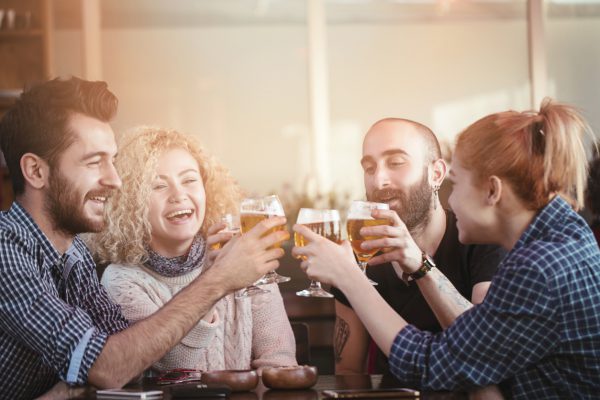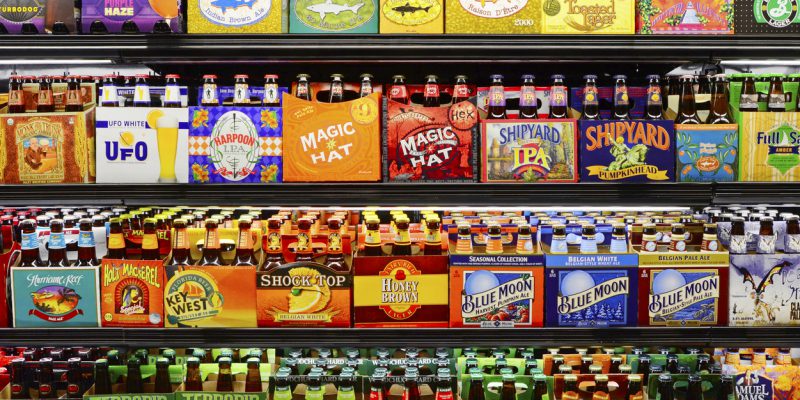In 2014 the New Yorker ran a cover featuring a stereotypically hipster-ish waiter cradling a bottle of beer as if it were a fine wine, displaying it for a pair of equally hipster-ish customers, one of whom was leaning his head back and swishing a taste of the golden liquid around in his mouth in the most affected way possible.
Let’s face it, the world of craft beer is often seen as a bit pretentious by those on the outside looking in. But it’s not just outsiders who sometimes have that feeling. In a 2014 survey 34% of craft beer drinkers agreed with the statement “Even though I love craft beer I have to admit there can be quite a bit of snobbery to it.”
Depending on where one sits this perception may or may not be seen as a problem for not only craft brewers and drinkers, but beer more generally. But the good news is that this certainly appears to be changing. Craft beer has made great strides in making itself more accessible to those on the fringes whose curiosity about the category may be tempered by the sense of intimidation that perceived snobbery can instill – a transition that we’re calling the democratization of craft beer.
Three trends have converged, it would seem, to chase the “snob appeal” out of craft beer and make it feel right for those who once restricted their choices to a Bud, Miller, or Coors: the growing expectation that craft beer can be found in cans; the continuing introduction and sales success of session IPAs and other more drinkable styles; and the rise of the neighborhood brewpub.

In 1935, long before there was anything called “craft beer,” Newark’s Gottfried Kruger Brewing Company became America’s first brewer to can its beer. Kruger’s innovation triggered a revolution in the way Americans drink beer – one that provided an early demonstration of the democratizing power of cans.
In that watershed year of 1935 draft beer accounted for 70% of all beer sales. According to Martin H. Stack’s “A Concise History of America’s Brewing Industry,” bottled beer was just too expensive for most people. Canning created the first affordable, convenient way to take beer home, and the market responded. Just five years later, draft beer accounted for only 48% of beer sales. Beer was presumably being enjoyed at home more often than ever before, by more people than ever before.
But bottles were still the package of choice for brewers who wanted to present a high quality image, and over the decades cans became associated with cheaper beers designed for budget conscious consumers. Thus, by the time the craft beer revolution was taking form in the 1970s and 1980s there was no question that the beer would be packaged in bottles and only bottles. Even among the relatively sophisticated audience for craft beer at the time there were few, if any, who would find it credible that a canned beer was a high quality beer. And while today many recognize that cans actually provide superior protection for the beer, at the time craft brewers lacked the time or the budget to educate their audiences about the impact of packaging on the precious contents.
In the 1990s a few craft brewers tried canning their beer, but the marketplace was neither ready nor receptive. This all changed in 2002 when Dale Katechis launched Oskar Blues Brewery, which took the audacious step of offering its packaged beer only in cans. Other brewers followed, and today cans represent over 8% of off-premise beer sales (according to IRI).
Canning did not, in fact, drag down the image of craft beer. But it does seem to have evolved that image somewhat by providing a more familiar, comfortable package for many drinkers. The fact that cans are popular in part because they’re easier to bring to outdoor events like hikes or picnics not only opens up more occasions to craft beer; the more relaxed, friendly vibe associated with those occasions can halo onto the beer itself.

The beer industry doesn’t need more commentary on the growth of IPAs; anyone close to the category has seen the trend first hand at the bar, read about the trend, wondered about the trend, and more than likely participated in the trend by having one or two themselves. And session IPAs are arguably the hottest IPA style of all, with off-premise dollar sales growing 25.3% in 2016, compared to 19.2% for the entire IPA category (according to IRI).
Session IPAs, strangely enough, may partially owe their success to a door opened by Miller Brewing Company when they introduced Lite Beer from Miller in 1974.
Lite’s impact on the beer world has been profound. The brand was successful precisely because it wasn’t positioned as a “diet beer,” but as a “less filling” beer for everyday drinkers (especially somewhat older drinkers) that enabled them to stay out for longer drinking sessions with their buddies. And thus was born the concept of “sessionability.”
In many ways craft brewers saw their beers as the solution to the opposite problem, i.e., too little flavor rather than too little sessionability. But the stronger taste (and often alcohol content) associated with craft beer sometimes reinforced the perception among mainstream drinkers that craft was a club that was a little too exclusive for them.
Then, in 2005, Full Sail Brewing introduced Session Premium Lager. Session Lager was still more flavorful than any of the mainstream beers, yet came in with similar alcohol content at 5% ABV. It seemed for a time that Session Lager would be nothing more than a novelty, a thing unto itself. But in the second decade of the 21st century a flurry of session IPAs from major craft brewers was released to rapid public acceptance and soaring sales. These for the most part stayed well-balanced while packing a surprising amount of hoppiness into beers with relatively low alcohol content by craft standards. The most successful example may be Founders All Day IPA, which was introduced in 2012 but already accounts for more than half of the breweries’ total sales and continues to grow – thanks in part to its popular 15-pack can package.
Session IPAs no doubt owe at least some of their success to increased consumption among long-time craft drinkers. But they’ve also made the category more accessible to new drinkers who had resisted craft because the idea that a good beer should be “challenging” to their palates seemed just a little too exclusive.
Another barrier to democratization had been eliminated.
Much has been written about the growth of brewpubs and brewery tasting rooms recently (including The Rise of the Brewpub). This industry trend owes its existence to several cultural trends, including people’s increasing tendency to embrace locally owned and operated businesses. The Yankelovich MONITOR, America’s longest running annual survey of the populace’s attitudes and values, reported in recent years that 51% of Americans now agree that they “try to buy from smaller local companies instead of large national companies as much as possible.” Among weekly beer drinkers the level of agreement rises to 60%; among weekly craft drinkers 71%.
The entire craft beer movement likely owes its existence in part to this trend, which began bubbling up in the 1970s and 80s. But while buying a beer from a craft brewery has often been a way to express local values, a visit to a brewpub often taps into hyper-local values. A craft brewery typically represents a city or a region; a brewpub or tasting room often represents little more than a neighborhood. They’re what’s known as “third spaces,” venues beyond home and work where people find a powerful sense of community.
This, too, has served to democratize craft beer. When beer drinkers can visit their neighborhood brewpub and find the comfort of discovering their friends and neighbors there, when they can meet the brewmaster himself or herself and discover that they’re not beer snobs after all, the intimidation factor just might be washed away.
And once that happens they may take their newfound interest in craft to the beer aisle at the grocery store, adding yet another to the ranks of America’s regular craft beer drinkers.

The Milwaukee suburb of Brookfield, Wisconsin is home to a Champps Americana franchise. On any given game day Champps is like any other sports bar – the place is packed with people watching the game on the big screen TVs while enjoying food and drinks, mostly beer. There’s one way, however, in which Champps might be different from the typical sports bar, at least the sports bar as history has known it. Champps features over 50 beers on tap, frequently including hard to find craft beers, and its website proudly boasts that it’s been called a “craft beer mecca.”
The Brookfield Champps may not be so unusual for very long, because it’s not really so much “different” as it is “ahead of the curve.” For years sports bars have been the last bastion of mainstream beer dominance. They’ve generally drawn clientele who are more interested in comfortable, familiar choices in terms of food, drinks, television programming, and life in general. But craft beer can now thrive in sports bars precisely because of democratization. Champps isn’t pulling a crowd full of hipsters out to Brookfield from Milwaukee’s trendier neighborhoods (well, maybe a few). The crowd on a given occasion consists mostly of people who would never be raising a glass of craft beer if there were so much as a whiff of pretense about it.
This is what the democratization of craft beer looks like in practical terms. And it’s a lot of fun to watch.



